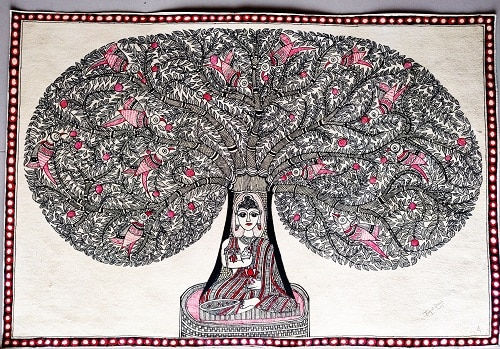Beyond Brushstrokes: Journey into the World of Madhubani Masterpieces
- DHRUVI GOHIL
- Jan 28, 2024
- 2 min read
The ancient art form of Madhubani painting has its roots in the Mithila area of Bihar, India. It is often referred to as Mithila painting and is among India's most colorful and ancient folk art forms. Madhubani paintings are distinguished by their vibrant and detailed designs, which frequently feature religious symbols, mythical themes, and images from daily life.
Photo credit-indianartideas.in
"In the intricate patterns of Madhubani, history unfolds, and tradition becomes a kaleidoscope of timeless beauty"Rich in symbolism, Madhubani paintings usually depict topics from Hindu mythology, the natural world, and religious ceremonies. Animals, birds, geometric designs, and deities like Krishna, Radha, Shiva, and Durga are common motifs. Stories from epics like the Ramayana and Mahabharata are frequently shown in the artwork. Madhubani paintings have a vivid color scheme made up of natural pigments. It's customary to utilize bright colors like red, yellow, green, blue, and black. Many times, the colors come from things found in nature, such as flowers, leaves, and minerals.
Photo credit-medium.com
The Mithila region's many communities and areas are linked to distinct kinds of Madhubani art. The primary fashions are:
-Bharni: This colorful style entails covering the entire area with elaborate designs.
-Kachni: Known for its exquisite details and precise lines, this style frequently illustrates themes from Hindu mythology.
-Tantrik: This style has intricate geometric patterns and is linked to ceremonial activities.
Photo credit-indianfolkart.org
Madhubani artisans create elaborate designs and delicate lines with brushes, twigs, and sometimes their fingertips. The paintings stand out for their accuracy and focus on detail. One characteristic of Madhubani painting that sets it apart is the use of double lines to delineate figures. Thanks to artists exhibiting their works on internet platforms, the worldwide reach of art has been enabled by the digital era. Its worldwide popularity has been aided by partnerships with foreign artists, integration with modern methods, and designation as a Geographical Indication. The ongoing influence of Madhubani painting on the global scene is further demonstrated by programs assisting artisan communities, educational seminars, and its incorporation into the fashion and textile industries, positioning it as a symbol of cross-cultural artistic exchange and the preservation of traditional craftsmanship.
Known as the "queen of Madhubani painting," Sita Devi is one of the most well-known Madhubani artists. Her paintings have won her praise from all over the world and the Padma Shri. Important stalwarts in the field, Ganga Devi and Mahasundari Devi, also attained international renown for their elaborate and culturally diverse works. Modern painters like Bharti Dayal have contributed to the changing field of Madhubani painting by creatively fusing traditional methods with contemporary themes. Every artist has been instrumental in maintaining, advancing, and increasing the attractiveness of this traditional Indian art form on a worldwide scale.
Photo credit-mapacademy.io
A few sequences in the 2015 historical film "The Man Who Knew Infinity," which tells the story of Indian mathematician Srinivasa Ramanujan, showcase Madhubani painting. In order to graphically depict Ramanujan's Indian ancestry within the story of his groundbreaking contributions to mathematics, the film delves into the man's cultural background.









Comments